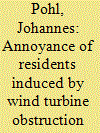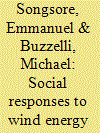|
|
|
Sort Order |
|
|
|
Items / Page
|
|
|
|
|
|
|
| Srl | Item |
| 1 |
ID:
179706


|
|
|
|
|
| Summary/Abstract |
Larger wind turbines are developed to harvest greater amounts of wind energy. This development increases the dilemma between ensuring aviation safety through obstruction lights and reducing citizen annoyance and possible stress effects caused by obstruction lights. In this study, a unique Danish sample is contrasted with a combined German-Swiss sample. Stronger stress effects due to the lights for the Danish sample compared to the German-Swiss study were found, an issue that could be related to the specific technical and site conditions. The prevalence of strongly annoyed residents was low. Significant factors for predicting obstruction light annoyance stress were identified, including: perceived fairness, consideration of the interests of the community, landscape change annoyance stress, number of visible wind turbines and age. It is recommended to enhance the planning process to reduce the stress among citizens, e.g. through improved communication, and to enhance the participation of residents in a way that allows for a meaningful consideration of people's concerns.
|
|
|
|
|
|
|
|
|
|
|
|
|
|
|
|
| 2 |
ID:
105803


|
|
|
|
|
| Publication |
2011.
|
| Summary/Abstract |
Although wind power is currently the most efficient source of renewable energy, the installation of wind turbines (WT) in landscapes often leads to conflicts in the affected communities. We propose that such conflicts can be mitigated by a welfare-optimal spatial allocation of WT in the landscape so that a given energy target is reached at minimum social costs. The energy target is motivated by the fact that wind power production is associated with relatively low CO2 emissions. Social costs comprise energy production costs as well as external costs caused by harmful impacts on humans and biodiversity. We present a modeling approach that combines spatially explicit ecological-economic modeling and choice experiments to determine the welfare-optimal spatial allocation of WT in West Saxony, Germany. The welfare-optimal sites balance production and external costs. Results indicate that in the welfare-optimal allocation the external costs represent about 14% of the total costs (production costs plus external costs). Optimizing wind power production without consideration of the external costs would lead to a very different allocation of WT that would marginally reduce the production costs but strongly increase the external costs and thus lead to substantial welfare losses.
|
|
|
|
|
|
|
|
|
|
|
|
|
|
|
|
| 3 |
ID:
193752


|
|
|
|
|
| Summary/Abstract |
We examine the impact of proximity to land-based commercial wind turbines on residential home values in the United States using data on the universe of commercial wind turbines and residential property transactions from 2005 to 2020. Using event study and difference-in-differences identification strategies we find that, on average, homes located within 1 mile of a commercial wind turbine experience approximately an 11% decline in value following the announcement of a new commercial wind energy project, relative to counterfactual homes located 3 to 5 miles away. Event study estimates also reveal important dynamics in the evolution of home values, with property values first declining following project announcement, and then recovering post project construction, with property value impacts becoming relatively small (∼2%) and statistically insignificant 9 years or more after project announcement (roughly 5 years after operation began). Homes located within 1–2 miles of a commercial wind turbine experience much smaller impacts and homes located farther than 2 miles away are unaffected. Our results are primarily driven by wind projects located in urban counties with populations greater than 250,000.
|
|
|
|
|
|
|
|
|
|
|
|
|
|
|
|
| 4 |
ID:
166994


|
|
|
|
|
| Summary/Abstract |
Existing studies regarding the impact of wind turbines on birds typically utilize data collected from a few wind facilities to estimate the impact at national level. This study examines the impact of wind turbines on breeding bird abundance by using a fine scale, spatial longitudinal dataset for 1,670 wind turbines and 86 bird observation routes located in 36 states in the United States over 2008–2014. We find that the establishment of one additional wind turbine, on average, leads to disappearance of about three breeding birds. The aggregate effect of the U.S. on-shore wind turbines on breeding bird count is 151,630, a magnitude at the lower end of existing estimates that range between 20,000 and 573,000. We also find that turbine size is a critical determinant of the magnitude of this impact, with turbine tower height positively, but blade length negatively, associated with aggregate breeding bird abundance. Grassland breeding bird abundance increases by up to 0.81 following the establishment of an additional wind turbine, although it is insensitive to tower height or blade length. Our findings provide important implications for policies related to wind facility siting and wind turbine development that can enhance the sustainability of wind energy.
|
|
|
|
|
|
|
|
|
|
|
|
|
|
|
|
| 5 |
ID:
171488


|
|
|
|
|
| Summary/Abstract |
Social media is a powerful communication tool through its universality and ease of access, which potentially has a huge impact on implementation of wind power. This study investigate a large corpus of Danish Facebook pages advocating anti-wind power viewpoints, distinguishing between localisation, different user groups, subjects and activity types. In doing this the following questions are answered: How localised are wind protests on Facebook?; To what extent can we perform a qualitative discourse analysis on different groups of Facebook users?; What can be said about the differences between community and cross-cutting Facebook users?; How are the voiced concerns articulated?; How are concerns managed by Facebook users?
|
|
|
|
|
|
|
|
|
|
|
|
|
|
|
|
| 6 |
ID:
117341


|
|
|
|
|
| Publication |
2013.
|
| Summary/Abstract |
How tangible are the costs of natural gas compared to the benefits of one of the fastest growing sources of electricity - wind energy - in the United States? To answer this question, this article calculates the benefits of wind energy derived from two locations: the 580 MW wind farm at Altamont Pass, CA, and the 22 MW wind farm in Sawtooth, ID. Both wind farms have environmental and economic benefits that should be considered when evaluating the comparative costs of natural gas and wind energy. Though there are uncertainties within the data collected, for the period 2012-2031, the turbines at Altamont Pass will likely avoid anywhere from $560 million to $4.38 billion in human health and climate related externalities, and the turbines at Sawtooth will likely avoid $18 million to $104 million of human health and climate-related externalities. Translating these negative externalities into a cost per kWh of electricity, we estimate that Altamont will avoid costs of 1.8-11.8 cents/kWh and Sawtooth will avoid costs of 1.5-8.2 cents/kWh.
|
|
|
|
|
|
|
|
|
|
|
|
|
|
|
|
| 7 |
ID:
132663


|
|
|
|
|
| Publication |
2014.
|
| Summary/Abstract |
This study documents and analyzes the role of health risk perceptions and other associated concerns of wind energy development (henceforth WED) in Ontario. Drawing on the risk society framework, we conduct a longitudinal media content analysis to document and analyze perceptions of and responses to WED over a nine year period. Attention is paid to temporal variations in responses relative to Ontario×s Green Energy Act (2009) (henceforth GEA); legislation aimed at the rapid expansion of renewable energy. The study reveals that the most radical forms of resistance to WED on health grounds are driven by perceived injustices in the treatment of potential at-risk citizens and citizens with health concerns. The GEA is fuelling these perceptions of injustices in subtle and nuanced ways, particularly by acting as a major confounder to health risk concerns. Contrary to several existing studies, we problematize the use of financial incentives to foster the development of wind energy. We also provide policy recommendations which include the need for increased public engagement in the WED process, the importance of using third party health and environmental assessments to inform developments as well as the need for post-development strategies to address ongoing community concerns.
|
|
|
|
|
|
|
|
|
|
|
|
|
|
|
|
| 8 |
ID:
111455


|
|
|
|
|
| Publication |
2012.
|
| Summary/Abstract |
On a $/kW basis, wind turbine prices in the U.S. have declined by nearly one-third on average since 2008, after having previously doubled over the period from 2002 through 2008. These two substantial and opposing trends over the past decade - and particularly the earlier price doubling - run counter to the smooth, gradually declining cost trajectories predicted by standard learning curve theory. Taking a bottom-up approach, we examine seven possible drivers of wind turbine prices in the U.S., with the goal of estimating the degree to which each contributed to the doubling in turbine prices from 2002 through 2008, as well as the subsequent decline in prices through 2010. In aggregate, these seven drivers - which include changes in labor costs, warranty provisions, manufacturer profitability, turbine scaling, raw materials prices, energy prices, and foreign exchange rates - explain from 70% to 90% (depending on the year) of empirically observed wind turbine price movements in the U.S. through 2010. Turbine scaling is found to have been the largest single contributor to the price doubling through 2008, although the incremental cost of scaling has been justified by greater energy capture, resulting in a lower cost of wind generation.
|
|
|
|
|
|
|
|
|
|
|
|
|
|
|
|
| 9 |
ID:
111456


|
|
|
|
|
| Publication |
2012.
|
| Summary/Abstract |
On a $/kW basis, wind turbine prices in the U.S. have declined by nearly one-third on average since 2008, after having previously doubled over the period from 2002 through 2008. These two substantial and opposing trends over the past decade - and particularly the earlier price doubling - run counter to the smooth, gradually declining cost trajectories predicted by standard learning curve theory. Taking a bottom-up approach, we examine seven possible drivers of wind turbine prices in the U.S., with the goal of estimating the degree to which each contributed to the doubling in turbine prices from 2002 through 2008, as well as the subsequent decline in prices through 2010. In aggregate, these seven drivers - which include changes in labor costs, warranty provisions, manufacturer profitability, turbine scaling, raw materials prices, energy prices, and foreign exchange rates - explain from 70% to 90% (depending on the year) of empirically observed wind turbine price movements in the U.S. through 2010. Turbine scaling is found to have been the largest single contributor to the price doubling through 2008, although the incremental cost of scaling has been justified by greater energy capture, resulting in a lower cost of wind generation.
|
|
|
|
|
|
|
|
|
|
|
|
|
|
|
|
| 10 |
ID:
122895


|
|
|
| 11 |
ID:
180135


|
|
|
|
|
| Summary/Abstract |
This paper examines the effect of wind turbines and solar farms on house prices. Using detailed data from the Netherlands between 1985 and 2019, the results show that tall wind turbines have considerably stronger effects on house prices, as compared to small turbines. For example, a tall turbine (>150m) decreases house prices within 2 km by , while a small turbine (<50m) has an effect of maximally and the effect dissipates after 1 km. Further results indicate that solar farms lead to a decrease in house prices within 1 km of about . By comparing the overall impact on house prices, we show that the external effects of solar farms per unit of energy output are comparable to those of wind turbines. Thus, building solar farms instead of wind turbines does not seem to be a way to avoid the external effects of renewable energy production.
|
|
|
|
|
|
|
|
|
|
|
|
|
|
|
|
|
|
|
|
|